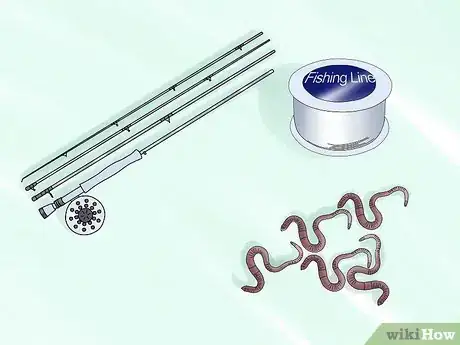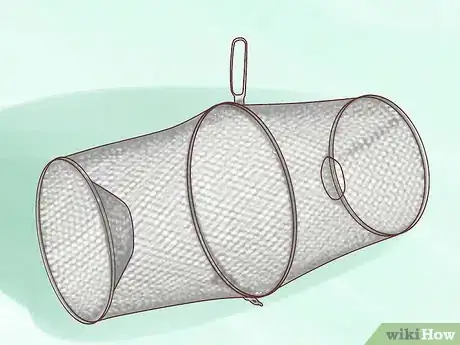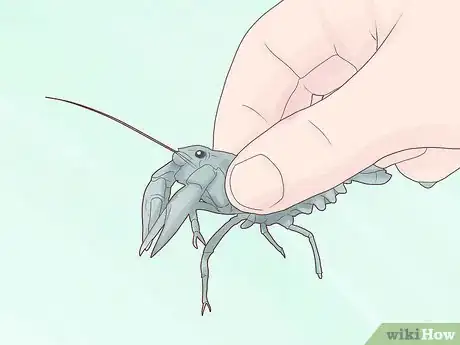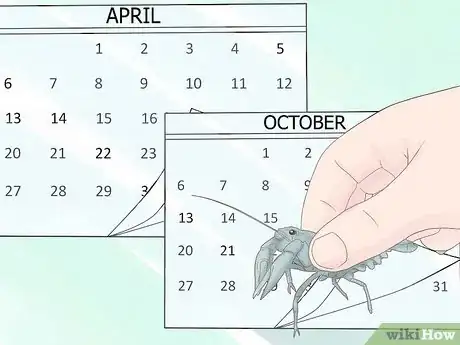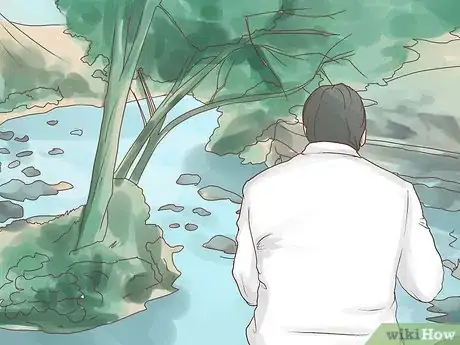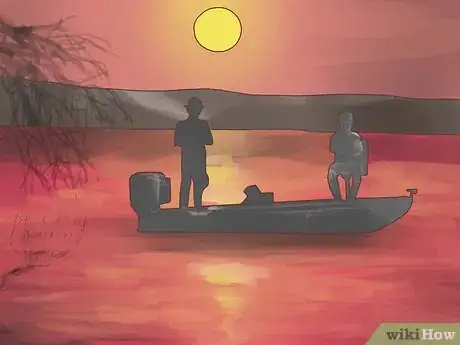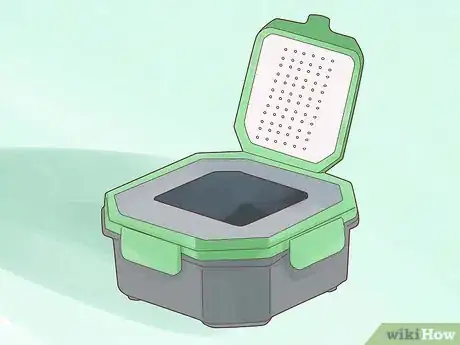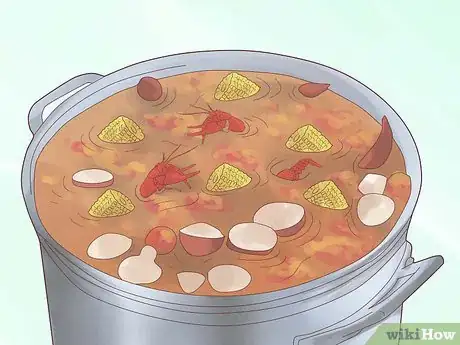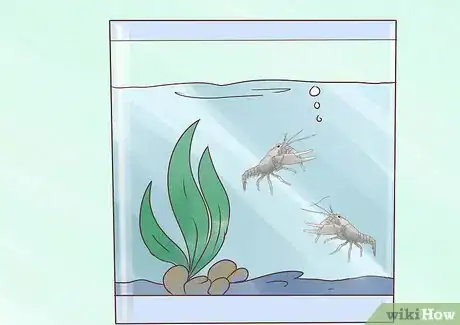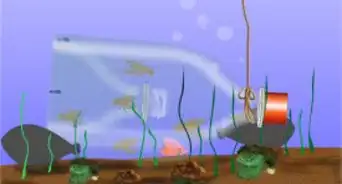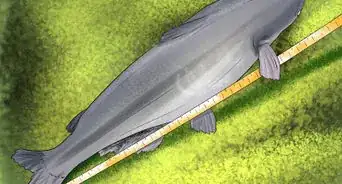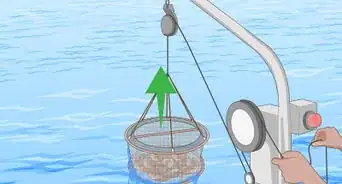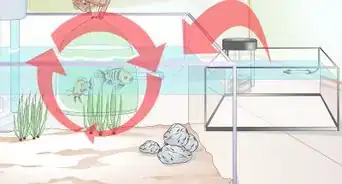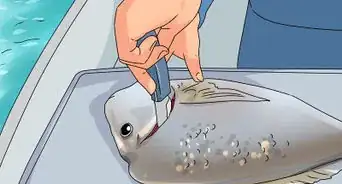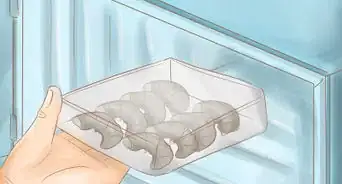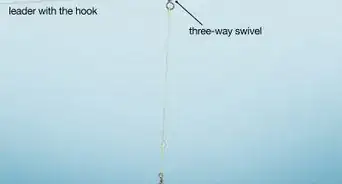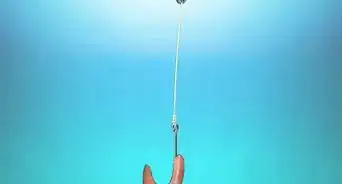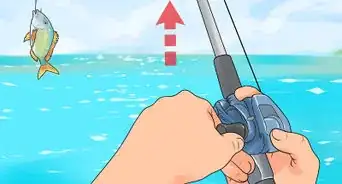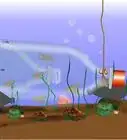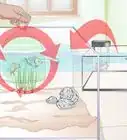wikiHow is a “wiki,” similar to Wikipedia, which means that many of our articles are co-written by multiple authors. To create this article, 34 people, some anonymous, worked to edit and improve it over time.
wikiHow marks an article as reader-approved once it receives enough positive feedback. This article received 15 testimonials and 91% of readers who voted found it helpful, earning it our reader-approved status.
This article has been viewed 456,326 times.
Learn more...
Crawfish—also known as crayfish or crawdads—are small, 10-legged crustaceans found in bodies of water across the U.S.A. and other countries. Catching them is a fun family activity that can be done using fishing poles, special traps, or even your bare hands! Once you're done you can turn these mini-lobsters into a tasty meal or bring one home as an unusual pinchy pet. Just make sure you only catch crawfish where it is legal to do so.
Steps
Choosing a Catching Method
-
1Try string and bait catching. String and bait catching is a simple way of catching crawfish and makes for a fun family activity. All you need is a fishing pole, rod or stick, some fishing line or string, and some bait.
- You can attach the bait to the string using a fishhook or even a safety pin—this will ensure that the bait remains attached to the string and prevents the crawfish from getting away. Artificial lures like grubs work well.
- Lower the bait into the water and jiggle it 1–2 inches (2.5–5.1 cm) from the bottom until you feel a tug on the end of the string. Then slowly move the crawfish and bait as close to the shore as possible before gently pulling it out of the water. Immediately place the crawfish into a bucket.
- If you like, you can use a fishnet with a long handle to scoop up the crawfish as soon as you reel them in. This will prevent them from releasing the bait and getting away.
-
2Use open or closed traps. Traps are the best way to catch large quantities of crawfish with relatively little effort. So if you want to feed your friends and family a crawfish feast, this is the way to go.
- There are 2 main types of traps: open traps, which are basically collapsible nets that are open on one end, and closed traps, a more advanced variety with a funnel on one end which allows the crawfish to enter the trap, but prevents them from escaping.
- Avoid using square-shaped traps as these can catch on rocks at the bottom of the water and become trapped or broken. Cylindrical-, conical- and beehive-shaped traps are all better options. Crawfish traps should be less than three feet in height, width, and depth.
- Before you lower the traps into the water, you will need to bait them. Some traps have a hook in the center to which you can attach the bait, while others require the use of bait boxes or bait jars.
- Open traps can be left in the water for several hours at a time, as long as there is enough bait, while closed traps can be left overnight. With any luck, when you pull the trap up again it will be filled with crawfish. Under the right conditions, you can catch 15–20 pounds (6.8–9.1 kg) of crawfish per trap!
Advertisement -
3Catch crawfish by hand. A third option for catching crawfish is just to catch them by hand, as they are often found amongst the rocks in shallow pools and can easily be picked up —just watch out for those sharp claws!
- To catch a crawfish by hand, you will need to find a pond, creek, or lake that is well known for its crawfish population. Crawfish typically like to hide under rocks and plants in the shallow parts of the water.
- To catch a crawfish, wade into the water and look for rocks that seem likely to be hiding a crawfish. Then very slowly reach your hand into the water and gently lift up the rock. If you lift it too quickly it can startle the crawfish and stir up mud which obstructs your vision, allowing the crawfish to scurry away.
- If you lift the rock correctly, you should see a crawfish just sitting underwater. Now you have two options. The first option is just to pick the crawfish up with your bare hands. If it's very small, you can reach your hands into the water and cup it between both hands. If it's larger, you can pick it up using the thumb and forefinger of one hand, just behind the pinchers.
- Your second option is to use a small bucket and stick. Gently place the bucket 4 to 6 inches (10.2 to 15.2 cm) behind the crawfish, then wave the stick in front of it or give it a light tap. Crawfish swim backwards, so it should swim directly into the bucket. Once it's in there, scoop the bucket out of the water.[1]
- Whatever you do, don't blindly thrust your hand into the water, or you could get a nasty pinch!
Catching Crawfish
-
1Get a fishing license. In many states, a fishing license is required to catch crawfish. However, once this license is acquired, you can catch as many crawfish as you like, 365 days a year.
- Family fishing licenses (which entitles any member of the family to fish) are available for purchase at your local state department, for a fee of approximately $60.
- When using crawfish traps, the license number must be engraved on or attached to the trap, along with your name and address.
-
2Go crawfishing between April and October. Crawfish are most active during the warmer months of the year, so the best time to go fishing for them is between April and October. However, it is still possible to catch crawfish during the colder months, just don't expect to find as many.
-
3Look for crawfish in freshwater lakes, ponds, and creeks. Crawfish are freshwater crustaceans and can be found in many bodies of water across the U.S.A. and in countries around the world.
- They make their homes in streams, ponds and lakes, in addition to canals, reservoirs, springs, and bedrock pools.
- Most crawfish prefer still or slow-moving water, with plenty of rocks and vegetation to provide cover. They are most likely to be found close to the bank or in a deep hole in the middle of a river, pond, or lake.
-
4Go crawfishing at night. Crawfish are nocturnal, which means they are most active at night, especially in warmer waters or during the summer months. Therefore, many people will set out to catch crawfish at dusk or will leave traps in the water overnight and collect them in the morning.
- If you plan on leaving traps in the water overnight, make sure to attach a piece of string tied around a cork. The string should be long enough for the cork to float on top of the water, accounting for the pull of the current.This will allow you to find the traps easily in the light of day.
- However, crawfish can still be tempted by bait during the day, so catching them during daylight hours is not impossible.
- Go fishing at whatever time works for you. Just remember that nighttime crawfishing expeditions can be a lot of fun!
-
5Use the correct bait. The best bait to use for crawfishing is widely debated, however, most sources will agree that you can't go wrong with the heads, tails, and guts of oily fish that are native to the local area.
- Fish like salmon, herring, carp, perch, walleye, and trout all work well as crawfish bait, but things like sardines, squid, clams, sole, and eel will not.
- Other options include any kind of fatty, raw meat such as chicken or pork. Crawfish are also attracted to pieces of hot dog and even fish-based cat food (though some crawfish experts would disagree with this).
- The most important thing when it comes to bait is that the meat is fresh. Crawfish will not be attracted to old, spoiled, or smelly meat, contrary to popular belief.
-
6Secure the bait properly. When you are using traps to catch crawfish, it is essential that the bait is properly secured.
- With some basic traps, the bait is simply hung from a hook in the center of the trap. This works well, but if the traps are left underwater for too long, the crawfish will eat all of the bait, then lose interest and escape from the trap.
- Therefore, many crawfish experts recommend using bait boxes—these allow the crawfish to feed and enable the smell of the bait to disperse through the water, attracting more crawfish. But because the bait is less accessible, it will not be eaten as quickly, so the crawfish remain in the trap for longer.
- Another option is bait jars—these allow the smell of the bait to disperse through the water but do not allow the crawfish to feed. The bait will last for longer, but the crawfish are not as likely to stay in the trap once they realize that they cannot feed.
Taking Crawfish Home
-
1Follow the laws regarding crawfish for your area. Be aware that some states forbid people from taking live crawfish away from their capture site. Some states (such as Arizona) forbid people from taking live crawfish home—they must be killed at the site of capture. So if you are considering bringing a crawfish home for a pet, make sure to look up your state's regulations first.
- Avoid releasing extra crawfish back into the water after you've caught them. Some states view crawfish as a pest and would like to reduce their numbers, as a result of the damage they've done to certain aquatic ecosystems. Therefore, you should get rid of the crawfish as humanely as possible or give them to another angler once you are done. You can also use them as bait when fishing for steelhead and salmon, particularly if they’re from the same river.
-
2Cook the crawfish if desired. Crawfish contain a delicious sweet white meat that can be eaten on its own or used in a variety of southern-style dishes such as crawfish jambalaya, crawfish etouffee, and crawfish bisque. Crawfish can also replace other shellfish such as lobster and crab in most dishes.
- First, kill the crawfish by thrusting a sharp knife between the head and thorax, or by submerging them in ice or boiling water for several minutes.
- To cook them, boil a pot of plain water and add some salt, black pepper, and cayenne for authentic Acadian seasoning. Rinse any mud or debris off the crawfish with clean water.
- If you wish to purge the vein inside the crawfish (intestines) before cooking, mix half a cup of salt or white vinegar with a bucket of clean water and leave the crawfish to soak in it for 30 minutes. When the water turns murky, they are ready to cook.
- Place the whole crawfish (or just the tails and large claws) into the pot of boiling water and leave for approximately 5 minutes, or until the shells turn bright red. If you like, you can add additional ingredients to the water such as seafood boil, onions, jalapenos, or cilantro.
- Eat the crawfish on their own, dipped in butter and lemon juice or covered in cocktail sauce. Serve with corn on the cob and boiled potatoes for a hearty post-fishing lunch or dinner. [2]
-
3Keep them as pets as an alternative. Some people like to keep crawfish as pets, as they are easy to care for and are fascinating for children to watch. Sometimes they can even be brought to school and kept as a classroom pet!
- Transport the crawfish by keeping them somewhere damp and cool. Do not place the crawfish in a bucket of water as most species need oxygen to survive and will die in stagnant water. As long as the crawfish is kept moist, it can survive out of water for several days.
- Keep the crawfish in an oxygenated aquarium on its own, as it will eat other fish. It can feed off any vegetation you place in the aquarium or you can feed it fish heads and trimmings, fatty meats, or any of the bait described above.
Community Q&A
-
QuestionWhat is the best location to go crawfishing?
 Community AnswerLook for lakes and ponds with a lot of rocks and a lot of vegetation.
Community AnswerLook for lakes and ponds with a lot of rocks and a lot of vegetation. -
QuestionWhat is the best bait for catching crawfish?
 Community AnswerHotdogs! I have caught dozens with a single slice of one. Crawfish are attracted to the pungent meaty aroma and will clamp right on.
Community AnswerHotdogs! I have caught dozens with a single slice of one. Crawfish are attracted to the pungent meaty aroma and will clamp right on. -
QuestionHow do you get rid of crayfish in your yard? They're taking over mine.
 Community AnswerTry trapping them in a smaller version of a lobster trap. Make a wire cage with a cone-shaped funnel entrance (small end inside the cage), and bait the cage with smelly bait similar to crab traps.
Community AnswerTry trapping them in a smaller version of a lobster trap. Make a wire cage with a cone-shaped funnel entrance (small end inside the cage), and bait the cage with smelly bait similar to crab traps.
Warnings
- Do your research before putting crayfish in an aquarium with other crayfish or fish. Crayfish like to eat fish and are territorial, and crayfish make good snacks for many fish species.⧼thumbs_response⧽
- Crayfish are aggressive aquarium pets and require lots of space. Don't keep them if you don't know how to.⧼thumbs_response⧽
- Beware of the pincers! Use your thumb and forefingers to pick up the crawfish just behind the pincers to avoid injury.⧼thumbs_response⧽
- Give your aquarium crayfish plenty of places to hide, especially when it is molting. Crayfish are especially vulnerable without their exoskeletons, which makes them an easy meal for other crayfish or fish.⧼thumbs_response⧽
References
About This Article
Before you can catch crawfish, you’ll need to obtain a fishing license in your state, which you can get at most sporting goods stores. Plan to fish between April and October, since these are the months when crawfish are the most active. Find a freshwater lake, pond, or creek, with still or slow-moving water and plenty of rocks and vegetation. You can either sit by the water at night and try to catch the crawfish by hand or with a pole and bait, or you can set a trap overnight and return the next morning to collect your catch. To learn what kind of bait to use to catch your crawfish, keep reading!
